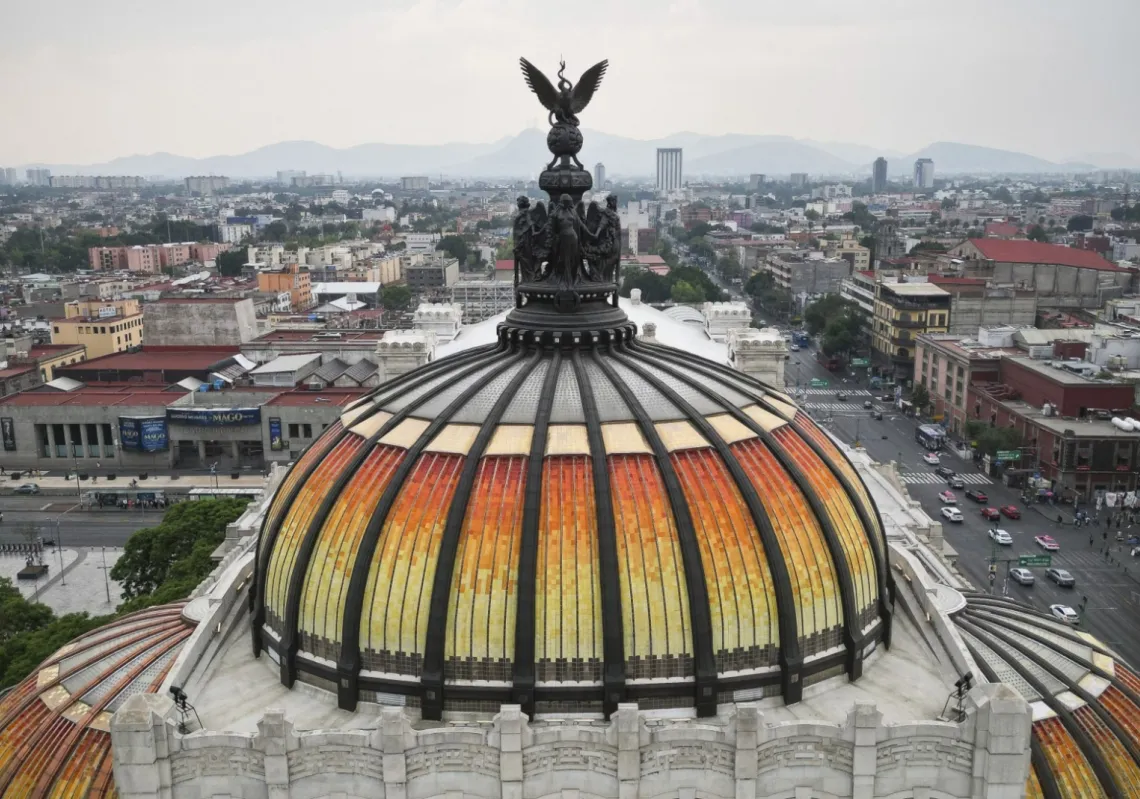There seems to be a lot going on right now in London’s cultural scene. Sadly, your reporter cannot be everywhere, so imagine my chagrin when I saw the pictures of celebrities gathering at the National Portrait Gallery yesterday, to mark its reopening.
There was Kate Middleton, aka the Princess of Wales, chatting with Sir Paul McCartney. There was the Eternally Young British Artist, Tracey Emin, whose portraits of women now adorn the gallery’s doors.
National Portrait Gallery reopens after three years https://t.co/rZsSSgMbKP
— BBC News (UK) (@BBCNews) June 20, 2023
And there, in the guise of ‘Claire’ – a fairy godmother dressed as a little girl – was the artist Grayson Perry who occasionally likes to dress that way.
Asked to comment on the occasion, he observed that everyone was preoccupied with identity nowadays. Then, with a dismissive cackle, he added that we all want to demonstrate what unique individuals we are.
This sounded odd coming from a man who has so strenuously attempted to set himself apart from the rest of us, yet who during lockdown seemed genuine in his encouragement of us amateur artists under temporary house arrest. Perhaps only Claire is this snide.
Where was I while all this was happening? You might well ask. Since London is but a short train journey from my rural home, I strive, in my own small way, to keep my finger on its pulse. I should have been there, among the talent and the big names. No one is more afflicted by FOMO than me.
So, it pains me to confess that I was in town, but in the wrong part. Not for me the ephemeral glitter of the rich and famous. I’ve been slumming it lately, one day at the Hayward Gallery looking at a ‘positive’ take on the climate crisis – I know, not the easiest brief for anyone – the next over at the Victoria and Albert Museum looking at the gaudy garments of the divas.
At the Hayward one can see a dead tree tilted at an alarming angle, a water feature, and an array of birds’ eyes staring at us accusingly:

One can also watch a film of the members of an Amazonian tribe railing against the gold miners who are destroying their environment and way of life. For those who have been living under a rock and have remained oblivious to the ravaging of the rainforest, this may be news.
What it does not amount to is good, positive news, and for all its efforts the Hayward exhibition remains as depressing as its pictures of extinct birds.

With my imagination yet to recover from the manifold threats to life on Earth, it was hard not to ask myself whether divas, for all their magnificence, could do much to save us from extinction. I guess the answer to this slightly churlish question would be an emphatic no.
True, these divas can save restaurants in Tottenham as Beyoncé just did, or create Rihanna’s forty-shade range of foundations designed for people of colour. Their fame and wealth can reflect the excesses of inequality back to us too.
Yet, with a suspension of disbelief, they can distract us from any of this, at least for as long as we are under the spell of idolatry.
The V&A has set out to tell the history of the diva from the days of opera and the music hall right up to the present. It helps that the museum has some gorgeous clothes in its collection with which to create a shrine to guilt-free idolatry.
Who in their right mind would not kneel in supplication to Cleopatra, for instance, whether she was played by Theda Bara, the silent movie vamp, Cher, or Elizabeth Taylor? The answer is, initially at least, Richard Burton. This is the kind of conversation one expects divas to be having on a daily basis.



The curators of DIVA manage to pay tribute to the power of the subject, without entirely defining what it is. They begin, promisingly enough, with the etymology, telling us that the word derives from the Latin for ‘goddess’ and quoting a French poet who said of one example ‘whenever she sings on the throne of gold, she assumes her star on the diadem of the diva’.
I wasn’t sure this helped clarify things, but the goddess idea takes care of one ingredient, a kind of immortality, which we see in the case of Theda Bara despite the destruction of most of her films.
We might say the same of Marilyn Monroe, represented here by a dress from ‘Some Like It Hot,’ or of Mae West, though the woman who gave us the following lines demonstrates another, optional, ingredient: in lieu of a decent singing voice, Mae West gave us sheer sassiness and double-entendres.
Long before Madonna was even born, and even longer before she wrote her coffee table book, Mae West had written a stage play entitled Sex – ripe for revival in the West End. Here we see her with Cary Grant, very slightly overdressed.


There is something else that becomes clear with contemporary incarnations of the goddess: an ability to transcend gender. Men such as Prince, Freddie Mercury and Sir Elton John manage to sneak into what is otherwise an exclusively female company.
In the case of Sir Elton, whose extraordinary outfit is a match for Rihanna’s papal parody, the Louis XIV references were laid on so thick he had to be transported to the party in a furniture lorry. This incident makes the strongest case I’ve ever heard for bringing back the sedan chair as a means of transport.

Perhaps the sheer dressiness of the diva shades inevitably into camp. Among the other ambiguous examples here, one confesses a love of fellow androids, another is unashamedly overweight, and a third has revolutionised our idea of maternity outfits.
There are showgirls who look like blokes and blokes who look like showgirls. There’s Josephine Baker, who popularised the Eton crop (it was first adopted by schoolboys, though never, unfortunately, by Boris Johnson) and cultivated an androgynous look.

Others subjected the feminine to a kind of hyperbole, such as Tina Turner or Cher. One wore pants that modesty forbids I even mention. Annie Lennox, who did a solo album called ‘Diva’, declared ‘I love to be individual, to step beyond gender.’
And Queen Bey herself had a track called ‘Diva’ in which she proclaimed herself to be 'a female version of a hustler,’ while leaving us guessing what one of those might be.
Yet, in contrast, a diva like Fairuz adopted a rigid stance which she attributed to stage fright and said she sang as if she was praying. Her Wikipedia entry describes her as being ‘incredibly reserved and modest in the way a mother would be’ and embodying ‘the Lebanese woman at home,’ though it would be unusual to find a homemaker dressed quite so strikingly.
Her voice is tinged with sadness as she recalls the unspoilt landscape of Lebanon’s idyllic past, one of tranquil mountain life, young love and carefree celebrations.

While this understated nostalgia is far from showy, she is no less a diva for that. Besides, the V&A’s definition is massively inclusive, also encompassing Billie Holiday, Billie Eilish, Amy Winehouse, Grace Jones, and a starry cast of larger-than-life figures who share a touch of the divine, and the kind of dress sense that can make lesser mortals gasp in admiration.
A few years ago, Dua Lipa – one diva that the museum has overlooked – was criticised by the Sun newspaper for having thrown a tantrum. Annoyed at the number of people popping into her changing room, she was said to have ‘ripped’ her name off the door and ‘slammed’ it behind her.
The tabloid commented that Lipa had behaved like ‘a right diva’. It’s just possible they meant ‘prima donna’. Whatever, I’m fairly certain that the diva in question took this in her stride. What goddess worth her salt ever gave the time of day to blasphemers?
So, to those who dare think these idols have feet of clay, consider the humble Wellington boot. At Glastonbury’s music festival, deep in the Somerset countryside, this has long been the footwear of choice owing to the inclemency of the English climate.
When the undoubted diva, Dame Shirley Bassey, showed up to perform there, she appeared in a pink dress designed (designers play hierophant to the modern goddess) by Julien Macdonald. On her feet, to keep the clay at bay, she wore wellies, but these came at the cost of £3,000 and were diamante-encrusted.

Given our adoring reverence for the diva, why would we expect her feet to make contact with the Earth?
‘Dear Earth: Art and Hope in a Time of Crisis’ is at the Hayward Gallery in London till 3 September 2023.
‘DIVA’ is at the Victoria and Albert Museum in London till 7 April 2024. Wear the headphones if you want to enjoy the music as you walk around!












